

de los REYES, Emilio (Pedro Betancourt 1920-New York 1987)


de los REYES, Emilio (Pedro Betancourt 1920-New York 1987)
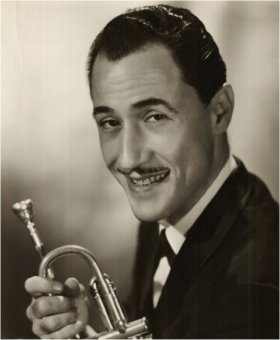 |
Emilio’s father, Walfredo I, is a dentist. His mother, Maria, teaches piano, and instills in her children a deep appreciation of music. Maria II (1908-1999), the oldest daughter, plays piano, and Walfredo II (1910-1982) studies trumpet. Francisco (1909-¿?) studies flute and would later play in the Banda de la Policia (Police Band) but dies of typhus in 1937. Rafael (1918-1952) studies trombone. Emilio, the youngest, studies trumpet and solfeggio with his older brothers. |
The children relocate with their parents to Havana, where Walfredo I establishes his dental practice in 1931. Meanwhile, Emilio sings as well as plays the trumpet, and music becomes his passion. In 1938 he joins a Jazz Style Band called « COSMOPOLITA » which has just been formed, in which he plays the trumpet and sings vocals, alternating frequently with Vicentico VALDÉS. He also performs with the orchestra “ALTOS de los C.O.P.O.”, and in 1940 when Walfredo II leaves the orchestra “CASINO de la PLAYA ”, Emilio takes his place. Emilio in 1938, with Cosmopolita.
|
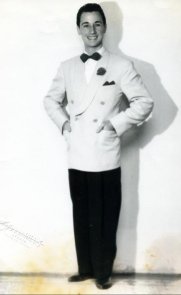 |
Without a doubt, Emilio participates in recordings made by said orchestra in 1942, and appears in Ernesto Caparrós’s short film Ritmos Cubanos with“CASINO de la PLAYA”. |
|
In 1943 Emilio forms his own orchestra “Emilio de los REYES y su ORQUESTA”, and is engaged by the Zombie Club, one of the most famous nightclubs of the era. While “CONJUNTO KUBAVANA” plays the dance music, Emilio accompanies the shows and plays dance music as well. Among the musicians that perform in Emilio’s orchestra during that period is the drummer Dani PÉREZ and the percussionist Guillermo ÁLVAREZ. In 1947 while still performing at the Zombie Club, Emilio and his orchestra is engaged by Bill Miller to perform at his famous club “The Riviera” located in Fort Lee, New Jersey in the United States.
|
This invitation coincides with Emilio’s desire to try his luck in the movies, so he accepts the contract. Visa problems force Emilio to postpone his trip and allow his musicians to leave ahead of him. As a result of the long delay, Emilio’s musicians accept an offer to work with Xavier CUGAT. When Emilio finally arrives in Manhattan, he abandons the idea of the movies and instead organizes a new orchestra with American, Puerto Rican and Cuban musicians to play in the nightclubs and hotels of the Big Apple. His brother Walfredo, who is currently living in Manhattan, helps him to find musicians. Emilio hires the boricua singer Irma Rodriguez (1924-2008) who had performed with MACHITO, Anslemo SACASAS, Noro Morales and American bands such as that of Hal Wayne at the famous Five O’Clock Club of Miami. Irma is also an excellent maraca player. Although Irma is hired to be the orchestra’s vocalist, Emilio will also perform vocals. Emilio debuts at Bill Miller’s Riviera Club. During that period he also performs in Brooklyn at El Patio, at the Tropical Room, the new chic club in Patterson, New Jersey, and at the Embassy Club in New York City.
|
Emilio de los REYES (also known as Emilio REYES), with his quintet composed of the Puerto Rican Pete Alonso on the drums; John Conquet on bass; Anthony Modafieri on piano, and Irma doing vocals, perform in early 1948 at the Parkville in Brooklyn. In addition to playing Cuban and Latin songs, Emilio also plays his renditions of jazz standards, such as “Stardust”, a much requested and beloved song when he performed on the island. He and his orchestra is engaged later in 1948 to accompany the much celebrated cabaret star Hildegarde (Hildegarde Loretta Sell), as well as other artists performing in the shows presented at the Raleigh Room of the Warwick Hotel. That year, the quintet performs in Chicago at the Hotel Sherry Supper Club where Irma is a sensation; at Don Julio’s in New York City, and in the WOR radio show presented from the Embassy Club in New York City. The following year, Emilio’s orchestra leaves Don Julio’s to fulfill a contract at the Hotel President in Atlantic City, New Jersey. |
 |
|
|
|
Emilio and Irma marry in 1949, and Irma continues singing with the orchestra until 1996, with occasional absences when their children are born. Emilio is hailed as the “Cuban Harry James”, and his Rhumba Band enjoys enormous popularity reflected in numerous articles in the newspapers of the period. During the early 1950s, the trumpet player and his orchestra perform at the most exclusive and prestigious night clubs, ballrooms, resorts and theaters in New York and surrounding cities.. .In New York they perform at La Martinique, the Arcadia Ballroom, The Towne House, the Havana Madrid, the San Juan Theater, City Center Casino the Celebrity Club, Club 500; in Livingston at the Waldemere; in Long Island at the Lido Beach Club, the Malibu Shore Club and the Great Neck Playhouse; and in New Jersey at the Palisades Amusement Park. Arcadia Ballroom. Irma and Emilio. |
During that period, “Emilio de los REYES and his ORCHESTRA” also perform in Brooklyn at Cascade Gardens, the Livingston, the Roadside, and the Town and Country Club. In Queens its the Boulevard that presents the orchestra, and in the Bronx, appearances at the Savoy Ballroom, The Aperion and the Stardust Ballroom contribute to the Cuban trumpet player’s success.
During the summer months, the resorts in the Catskill Mountains of New York engage numerous bands, and the de los REYES band begins the first of many engagements at The Pines and at Grossinger’s. The band’s engagements with The Pines span the late 1940s until the 1980s, and at Grossinger’s from 1951 though 1979. The band does not neglect the hotels, and the “Emilio REYES ORCHESTRA” is invited to play in the ballrooms of the Waldorf Astoria, at the Hotel Riverside, at the Plaza Hotel, the Statler Hilton Hotel, the Vanderbilt, the Hotel St. George and many others.
|
|
The orchestra’s debut at the famous and historic Roseland Ballroom and Chateau Madrid in 1952 were momentous occasions, since Emilio will later begin a long engagement at the select Chateau Madrid which will last from 1957 until 1969; and the orchestra will return to Roseland Ballroom in 1979 and perform there until 1996, when Roseland discontinues ballroom dancing and becomes a concert hall. Emilio de los Reyes Orchestra. Années '50. Emilio de los REYES records his first 78 rpm single in 1952 with MGM Records, featuring the instrumental “Black Pearl,” and “Amorcito Corazon” featuring Irma’s vocal performance.
In 1955, Emilio de los REYES and his orchestra are chosen to appear on Jackie Gleason’s television program “America’s Greatest Bands.” |
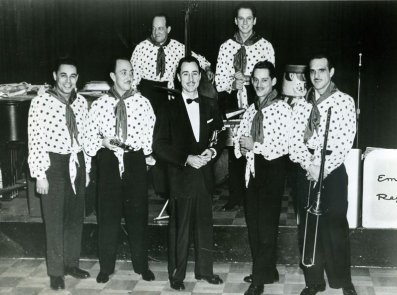 |
Emilio de los REYES introduces his four year old daughter, María, with the orchestra in 1955 during his engagement with the Golden Slipper in Glen Cove, Long Island that year as well as the following year. She sings with her parents, and will continue to sing with the orchestra at many of the locations at which the orchestra performs. During the second half of the 50s, Emilio de los REYES performs at new nightclubs, cabarets and hotels, commencing with the Hi-Ho Casino and Albermarle Towers in Brooklyn; New York City welcomes the orchestra at the RKO Hamilton Theater and the Village Gate in 1957 and 1959 respectively, while in New Rochelle, New York, the El Dorado Shore and Yacht Club engages the orchestra for the summer months of 1957 through 1962. |
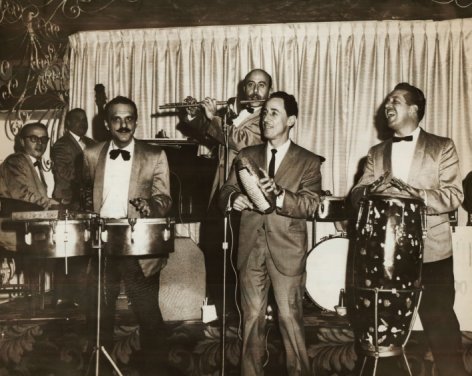 Emilio's Orchestra at Chateau Madrid. |
A second series of recordings in 1956 result in the album “An Occasional Cha Cha Cha” on Mardis-Gras Records. Two songs are performed by Johnny Velasquez and his orchestra, “Time on My Hands” and “Son Retozon.” Emilio and his orchestra perform the remaining eight songs, and he selects from the hits of the day cha cha chas, mambos, sones ...”An Occasional Man”, “Cafe Mambo” , “Guess Who Does the Cha Cha Cha”, “Dansero Cha Cha”, “Delightful Cha Cha” and he introduces his original composition “Margarita Cha Cha”.
|
Mardis- Gras Records also selects various of Emilio’s songs to include in subsequent albums released in the late 50s featuring a variety of artists. Two of these albums are Volumes 1 and 2 of the “Mardis-Gras All Stars”. Among the musicians upon which Emilio relies during the late 50s are the pianists Eddie del Barrio, George del Barrio and Javier Velasquez, the flute players Dick Maldonian, Dennis Brault and frequently his brother Walfredo. In 1961, having left MACHITO’s orchestra, the great jazz saxophonist Jesús CAUNEDO joins Emilio’s orchestra, and performs with him at the Chateau Madrid, and in the Catskills. |
During the early 60s, the performances continue in the clubs and cabarets of the prior decade, and Emilio adds to these the Airport Club in Brooklyn. He returns to the studio in 1960 to record the album “Merengue!” on Decca Records, in which he sings and plays his trumpet. The album includes the songs “Pachanga,” “That Old Black Magic,” Easy Merengue,” “La Escalerita,” “Apagame La Vela,” “Get Happy Merengue,” “I know that You Know-Merengue,” “Comiendome Un Cable,” “Just A Minor Merengue,” “I Want to Be Happy Merengue,”. Emilio’s arrangement and adaptation of “National Emblem Merengue,” and his personal composition “Trumpet in Merengue.” |
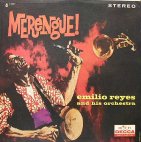 |
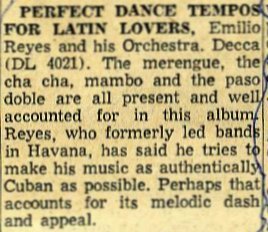 |
Emilio records a second album for Decca Records, “Perfect Dance Tempos For Latin Lovers” the following year which will define the period, and receive rave reviews in the press. The album introduces a second personal composition of Emilio’s, “Guajiro Cha Cha Cha,” also known as “Coral Falso,” his personal arrangements and adaptations of "Mi Guantanamera” and “Quirino Con Su Tres,” and the songs “Loma de la Cruz,” “Son de la Loma,” “Que te Parece Cholito,” “Anything Goes,” “Nunca,” “Besame Aqui Nena,” “Amor De Mis Amores,” “Havana to Madrid” and “Carmencita.” |
The 60s see the orchestra perform on the most important stages of New York and the East Coast. This is the golden era during which the great clubs have various groups on their billboards, and “Emilio REYES and his ORCHESTRA” appear on these billboards with other Latin music greats such as Noro Morales, Tito Puente, MACHITO... |
 |
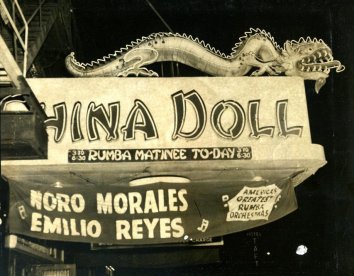 |
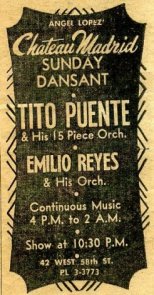 |
In 1965, while performing at the Brighton Beach Baths, Emilio introduces his seven year old son, Rafael, with the orchestra, who begins to sing with Irma and María, and would later take his place at Emilio’s side. Rafael, María and Irma.
|
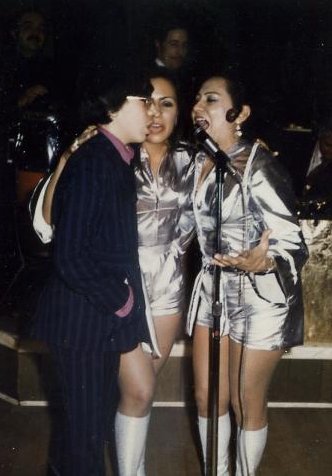 |
Every year with regularity during the early 70s, Emilio performs during the summer months at the Villa Nueva in Plattekill, New York, and among his musicians during those years are the pianists Miguel Carbone, Joe Mannozi and Peter Latin, saxophonist Bob Mover; bass player Cucho Martínez; the drummer Johnny “La Vaca” Rodríguez... At the end of the 70s, Emilio returns to Roseland Ballroom. |
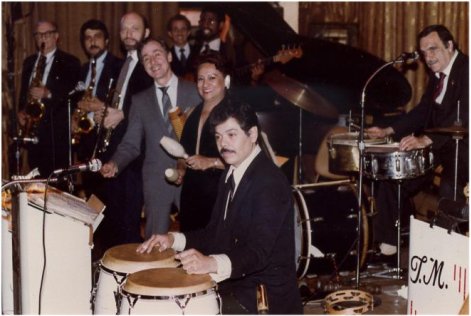 Emilio, Irma, conguero Ray Mantilla, Cuban drummer Antonio García. |
In the early 80s, “Emillio de los REYES and his ORCHESTRA” continues their appearances during the summer months at The Pines and the Villa Nueva in the Catskills , and he also performs at the Commodore Hotel in New York City. This last decade, however, is defined by his presence on the stage of Roseland Ballroom where he performs until 1987, with Irma singing at his side, and frequent appearances by María on vocals as well. The repertoire, which spans Cuban, Brazilian, American, Italian and other music includes Emilio’s personal compositions, such as “Se Me Para El Reloj,” “My Fantasy,” and “Elevate Un Poquito.” Emilio’s musicians during this period include trumpet players Bill Moriarity, Jordan Sandke, Tony Barreto and Kent Smith; saxophonists Bill Morimando, Mitch Endick and Charlie Harmon; pianists Steve Samberg, Ernesto Santos and Alfredito Valdés Jr.; bassists Bobby Rodríguez, Guillermo Edgehill, Alex Rodríguez, and Cucho Martínez, drummers Antonio García, Rafael de los Reyes and Ray Mantilla...
Roseland Ballroom. '80. |
In February of 1987, a severe headache attacks Emilio while he is performing on stage at Roseland. He is admitted to the hospital shortly thereafter, and dies several weeks later. The trumpet player Bill Moriarity assumes the position of director of the “Emilio de los REYES ORCHESTRA” for the following two years. Irma and Rafael continue to perform with the orchestra, and Rafael assumes the position of director of the orchestra in 1989. The orchestra performs at Roseland until the Ballroom discontinues live ballroom dancing and transforms into a discotheque and Rock and Roll concert hall in 1996. |
© Patrick Dalmace/ Maria de los Reyes, Rafael de los Reyes. Translation: Maria de los Reyes.
© Photographies Collections Maria et Rafael de los Reyes.
| Discographie
sélectionnée: ....Biographies....
|